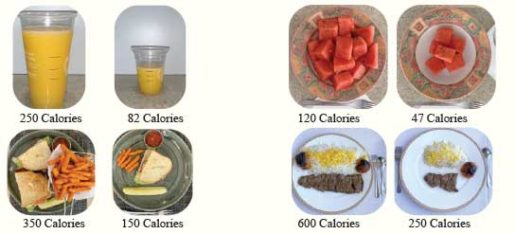Educational Series
The Science of Nutrition
By Mohammad Ahrar, PhD
Introduction
When we eat delicious Iranian food, we sometimes forget how much (or, rather, how little) food we need to eat. Portion size and the caloric content in the amount of food that we eat are directly related to maintaining a healthy weight. The subject of weight control and prevention of obesity is so important that we have discussed it in several issues of Peyk. In this issue, we discuss how maintaining a healthy weight influences our decisions about portion size.
Healthy weight
Maintaining a healthy weight—also known as weight management—is simply a game of caloric intake and calories spent. A calorie is a unit of energy, a measurement that describes how much energy a given food or drink can provide and how much energy a person “spends” (calories burned) during a day. In most scientific sources, a Kilo calorie or Calorie (with capital C) is used as the unit of energy. Each Calorie is equivalent to 1000 “small” calories. According to the Mayo Clinic, a healthy weight is statistically correlated to good health.
BMI—The Common Guideline For Estimating Healthy Weight
The Body Mass Index (BMI) is a guideline for estimating healthy weight and is widely used by most medical institutions. It gives a fairly accurate assessment of how much fat is in a particular body. BMI is based on a person’s weight and height and is an effective way to evaluate whether a person is in a healthy weight range, is overweight, or is obese. Reports from the Harvard Medical Center indicate that the terms overweight and obesity are not the same, as “obesity is a serious, chronic disease that can inflict substantial harm to a person’s health.” Information about the use of the BMI chart was explained in Peyk #166. Although BMI shows the percentage of fat in the body, the chart below also can be used to find out what a person’s healthy weight should be.
To see what your ideal weight should be, simply find your height at the top of the chart. If you move down the column to the green zone, you will find values between 24 and 19; your healthy weight should be any number on the very left (weight column) that corresponds to the values in the green zone. For example, if your height is 5 feet and 7 inches (170 cm), your healthy weight should be 155 pounds (70.3 Kg.) or less.

Calories Needed Per Day
The amount of calories each person needs depends on many factors, including different degrees of physical activity. The table below shows an estimate of caloric need by different groups of people.
Portion Size’s Effect On Weight
Weight control can be difficult for some people to do, as there are numerous factors that are involved in maintaining a healthy weight. Portion size is a simple visual factor that can remind us about caloric intake and help us choose the amount of food we need to eat to keep our weight under control. The pictures below compare the estimated caloric value of a few foods in different portion sizes. For example, 6 ounces of orange juice contain only 82 Calories, compared to 246 Calories in 18 ounces.

The food sample photos were randomly chosen and are only for comparison of portion sizes, and the caloric values are estimates. You have the option of choosing the portion size of any food that you like to eat. The photos are not for promoting or suggesting that any of the foods shown should or should not be consumed. Some restaurants may have calorie chart for their food. All chain restaurants in the U.S. with 20 or more outlets are federally mandated to list the caloric values of their foods. In addition, with the exception of fresh produce, food packaging—like that found in grocery stores—should list nutritional values.
What Portion Size Tells Us
The photos above remind us that our eating habits and the choices we make about the portion size of foods can influence our caloric intake. The pictures also show us how easily we can control our weight by choosing the right portion size. Weight gain does not happen overnight—it takes months and years to show any changes to our weight. Losing weight also does not happen overnight and requires less caloric intake over many months or years to lose the desired amount of weight. By selecting a portion size, we can make better choices to maintain or to reach our goal of healthy weight.
Medical Tips For Healthy Weight
Medical studies are in favor of increasing physical activity rather than eating less food in the effort to lose weight. Muscles use much more energy than other organs of the body. Any time you use your muscles, even for a few steps of walking or going up and down a set of stairs, or other physical activities, you lose calories. On the other hand, lying down and watching TV for long hours does not help you lose any weight.
Watch for carbohydrates
Carbohydrates are used as the main fuel source for cellular metabolism. Glucose, for example, is a simple carbohydrate which provides energy for all cells in the body, especially brain cells that are totally dependent on glucose for energy. However, we should be careful about how much and what type of carbs to include in our diet and avoid the carbs that causes a spike of blood sugar.
Blood sugar level and Glycemic Index
According to Harvard Medical School, blood glucose levels above normal are toxic and can cause blindness, kidney failure, or increase cardiovascular risk. It is important to know what foods increase blood glucose level very sharply. The Glycemic Index is widely used for this purpose.
Glycemic Index (GI)
The GI shows how quickly different foods can elevate the blood sugar. Foods with high GI, such as sugary drinks, spike an insulin release from the pancreas. Insulin is referred to as a fat-producing hormone. The fat cells in the body are programmed to make fat from glucose rather than burn the glucose to produce heat and chemical energy. If, for example, you eat a large banana or a large glass of fruit juice or a can of sugary soda, your blood sugar level increases very rapidly. Please visit Peyk 165 for the GI chart of some common foods.
Consider high-fiber foods
Consuming foods that contain fiber and choosing the right potion size can eliminate the sudden blood sugar spike and the complications of high blood sugar. For example, a 100-calorie serving of almonds affects your body much differently than 100 calories worth of a candy bar. Almonds have fiber, protein, healthy fats, vitamins, and minerals, whereas a candy bar contains mostly sugar and saturated fat. A handful of almonds will give you sustained energy; a candy bar will probably cause your blood sugar to spike and crash.
Vegetables in diet
Vegetables have zero or very low GI. Consuming vegetables with high glycemic index foods such as white rice and potatoes can lower the absorption rate of glucose in the small intestine and therefore reduce the rapid increase in blood sugar.
Exercise
What’s the one prescription that can lower your risk for 5 major diseases with no side effects? The answer is exercise. The benefits of exercise have been reported by Mayo Clinic, Harvard Medical School, and many research institutes. A recent study conducted at UCLA shows that exercise relieves stress and, in the long run, promotes the growth of neurons in the brain. Results of other studies indicate that physical activities that makes you breathe faster enhances oxygen transport to the brain, increases levels of serotonin and other mood-lifting hormones in the brain, improves memory and brain activity, and delays or prevents Alzheimer’s disease. For more information about the benefits of exercise, please visit Peyk #168 (https://pccsd.org/All-peyk/No%20168/Peyk168-English-web.pdf ).
Selected Sources
http://www.foodnutritiontable.com/nutritions/
www.globalrph.com/estimated_energy_requirement.htm


















